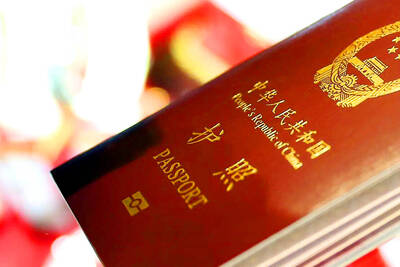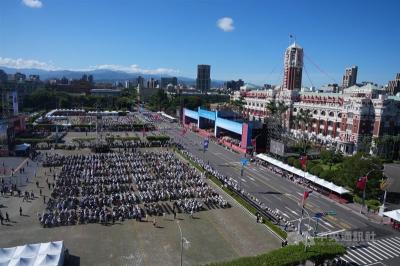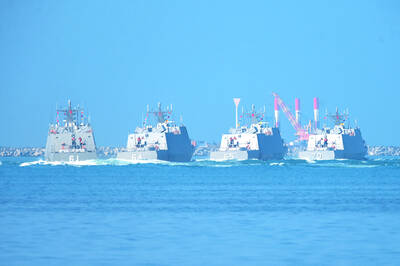Taiwan would continue to work with the US, Japan and South Korea on regional security, the Ministry of Foreign Affairs (MOFA) said yesterday, after the three countries issued a joint statement on the matter.
The statement was issued to coincide with the anniversary of the Trilateral Leaders’ Summit at Camp David on Aug. 18 last year, when US President Joe Biden, Japanese Prime Minister Fumio Kishida and South Korean President Yoon Suk-yeol met at Camp David in Maryland.
In it, the three leaders reiterated a commitment to “shared goals of advancing security and prosperity for the [Indo-Pacific] region and the world.”

Photo: AP
“Over the past year, we have demonstrated our unwavering commitment to these shared objectives through close consultation and coordination on priorities in the Indo-Pacific and beyond,” the statement said.
It is also Taiwan’s responsibility to safeguard peace, stability and prosperity across the Taiwan Strait and in the Indo-Pacific region, the ministry said.
Security in the Indo-Pacific region is an issue of importance to the international community as a whole, demonstrated by a number of multilateral meetings on the matter, it said.
Those meetings have included the Trilateral Leaders’ Summit and the Trilateral Indo-Pacific Dialogue between the US, Japan and South Korea, the US-Japan-Philippines trilateral summit, the US-EU High-Level Consultations on the Indo-Pacific, and the Australia-United States Ministerial Consultations, among others, the ministry said.
In related developments, while speaking at the Indo-Pacific Irregular Warfare Symposium held in Honolulu from Tuesday to Thursday last week, US Indo-Pacific Commander Admiral Samuel Paparo said that the US Indo-Pacific Command has not invested enough in its special operations forces (SOF).
His comment reveals that the US is considering the role that special operations forces might play in the face of serious security challenges in the Indo-Pacific region, but that it is also facing a dilemma regarding the allocation of resources, a source said.
Paparo also defined special operations forces as “cognitive space,” implying the importance of special operations in information warfare, which is beyond the scope of traditional military operations, the source said.
Regarding Taiwan’s strategic importance, Paparo said that it is “important to all of the nations that matters not be settled by force.”
He also said that China “claims an absurd footprint of sea space that defies logic, that impinges not just on the Republic of the Philippines, but every state within the South China Sea.”
Paparo said he was optimistic about the US military’s incorporation of new technology, including drones.
“I have this principle — I think we should all share it — which is to not send a human being to do a dangerous thing that you can send a machine to do,” he said.
However, the use of such technology should be accompanied by human morality and accountability, Paparo said.
In terms of information gathering, the US should be “in and among our adversaries, learning from them,” while also ensuring that adversaries do not learn from the US, he said.
“The time is now to get the SOF enterprise focused on the Indo-Pacific to the extent that we can,” Paparo said.
Special operations, alliance cooperation, technological innovation and information operations are of growing importance to US interests in the Pacific, he added.

The Ministry of the Interior (MOI) is to tighten rules for candidates running for public office, requiring them to declare that they do not hold a Chinese household registration or passport, and that they possess no other foreign citizenship. The requirement was set out in a draft amendment to the Enforcement Rules of the Public Officials Election and Recall Act (公職人員選舉罷免法 ) released by the ministry on Thursday. Under the proposal, candidates would need to make the declaration when submitting their registration forms, which would be published in the official election bulletin. The move follows the removal of several elected officials who were

The Republic of China (ROC) is celebrating its 114th Double Ten National Day today, featuring military parades and a variety of performances and speeches in front of the Presidential Office in Taipei. The Taiwan Taiko Association opened the celebrations with a 100-drummer performance, including young percussionists. As per tradition, an air force Mirage 2000 fighter jet flew over the Presidential Office as a part of the performance. The Honor Guards of the ROC and its marching band also heralded in a military parade. Students from Taichung's Shin Min High School then followed with a colorful performance using floral imagery to represent Taiwan's alternate name

FOUR DESIGNATED AREAS: Notices were issued for live-fire exercises in waters south and northwest of Penghu, northeast of Keelung and west of Kaohsiung, they said The military is planning three major annual exercises across the army, navy and air force this month, with the navy’s “Hai Chiang” (海強, “Sea Strong”) drills running from today through Thursday, the Ministry of National Defense said yesterday. The Hai Chiang exercise, which is to take place in waters surrounding Taiwan, would feature P-3C Orion maritime patrol aircraft and S-70C anti-submarine helicopters, the ministry said, adding that the drills aim to bolster the nation’s offshore defensive capabilities. China has intensified military and psychological pressure against Taiwan, repeatedly sending warplanes and vessels into areas near the nation’s air defense identification zone and across

A Chinese takeover of Taiwan would severely threaten the national security of the US, Japan, the Philippines and other nations, while global economic losses could reach US$10 trillion, National Security Council Deputy Secretary-General Lin Fei-fan (林飛帆) wrote in an article published yesterday in Foreign Affairs. “The future of Taiwan is not merely a regional concern; it is a test of whether the international order can withstand the pressure of authoritarian expansionism,” Lin wrote in the article titled “Taiwan’s Plan for Peace Through Strength — How Investments in Resilience Can Deter Beijing.” Chinese President Xi Jinping’s (習近平) intent to take Taiwan by force